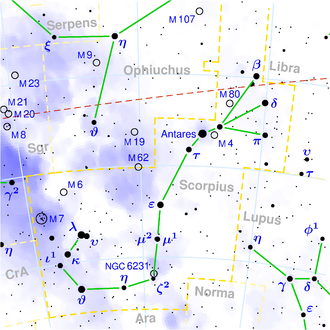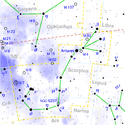NGC 6000
| Galaxie NGC 6000 | |
|---|---|
 | |
| Aufnahme des Hubble-Weltraumteleskops | |
| AladinLite | |
| Sternbild | Skorpion |
| Position Äquinoktium: J2000.0, Epoche: J2000.0 | |
| Rektaszension | 15h 49m 49,5s[1] |
| Deklination | -29° 23′ 13″[1] |
| Erscheinungsbild | |
| Morphologischer Typ | SB(s)bc: / HII / Sbrst[1] |
| Helligkeit (visuell) | 12,2 mag[2] |
| Helligkeit (B-Band) | 13,0 mag[2] |
| Winkelausdehnung | 1,9′ × 1,6′[2] |
| Positionswinkel | 154°[2] |
| Flächenhelligkeit | 13,3 mag/arcmin²[2] |
| Physikalische Daten | |
| Rotverschiebung | 0,007315 ± 0,000003[1] |
| Radialgeschwindigkeit | (2193 ± 1) km/s[1] |
| Hubbledistanz vrad / H0 | (96 ± 7) · 106 Lj (29,3 ± 2,1) Mpc [1] |
| Geschichte | |
| Entdeckung | John Herschel |
| Entdeckungsdatum | 8. Mai 1834 |
| Katalogbezeichnungen | |
| NGC 6000 • PGC 56145 • ESO 450-G020 • MCG -05-37-003 • IRAS 15467-2914 • 2MASX J15494955-2923124 • | |
NGC 6000 ist eine Balken-Spiralgalaxie vom Hubble-Typ SBbc im Sternbild Skorpion auf der Ekliptik. Sie ist schätzungsweise 96 Millionen Lichtjahre von der Milchstraße entfernt und wird als Starburst-Galaxie klassifiziert.
Die Galaxie wurde am 8. Mai 1834 von dem Astronomen John Herschel mithilfe seines 18,7 Zoll-Spiegelteleskops entdeckt und später von Johan Dreyer in seinen New General Catalogue aufgenommen.[3]
Weblinks
Einzelnachweise
Auf dieser Seite verwendete Medien
Autor/Urheber: Torsten Bronger., Lizenz: CC BY-SA 3.0
This is a celestial map of the constellation Scorpius, the Scorpion.
The yellow dashed lines are constellation boundaries, the red dashed line is the ecliptic, and the shades of blue show Milky Way areas of different brightness. The map contains all Messier objects, except for colliding ones. The underlying database contains all stars brighter than 6.5. All coordinates refer to equinox 2000.0.
The map is calculated with the equidistant azimuthal projection (the zenith being in the center of the image). The north pole is to the top. The (horizontal) lines of equal declination are drawn for 0°, ±10°, ±20° etc. The lines of equal right ascension are drawn for all 24 hours. Towards the rim there is a very slight magnification (and distortion).Autor/Urheber: Judy Schmidt from USA, Lizenz: CC BY 2.0
A picturesque spiral galaxy perhaps most notable for being the 6000th entry in the New General Catalog. Hubble has looked at this galaxy a few times for stellar and galactic surveying, but never specifically because there is anything about this galaxy that makes it interesting on its own. Beautiful, but typical. I will say that the small, bright spiral in the nucleus amuses me. If I were to turn it 180°, it would be a 6, which would be fitting for it since it is NGC 6000. However, I think that would look "upside-down" if there is such a thing for galaxies.
There is an asteroid trail somewhere in this picture.
The chip gap was filled with cloned data. The image has clarity, sharpness, and saturation adjustments.
Data from Proposal 15166 were used to create this image. Continuing a Snapshot Survey of the Sites of Recent, Nearby Supernovae: Cycles 25 & 26
Red: WFC3/UVIS F814W Green: Pseudo Blue: WFC3/UVIS F555W
North is NOT up. It is 60.43° clockwise from up.


